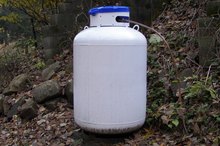Cause of Chills in a Warm Environment
Experiencing chills in a warm environment is a result of the muscles quickly contracting and relaxing in an attempt to increase the body’s temperature. Chills often accompany or preclude fever but may also be symptomatic of nonfever-related conditions. The causes of chills in a warm environment range from simple infections like the common cold to more serious health threats that require medical attention.
Hemolytic Anemia
Hemolytic anemia is one cause of chills in a warm environment and is caused by an insufficient number of red blood cells in the body. Hemolytic anemia is a broad umbrella term, but there are various types of hemolytic anemia, including sickle cell anemia, malaria and thalassemia. The condition may also be the result of chemicals and toxins, or a blood transfusion from a donor with a dissimilar blood type.
Cancer
What Are the Causes of Chills and Night Sweats?
Learn More
In cancer patients, chills and fever may be the result of a tumor or an infection. In addition, the chills and fever may be a negative reaction to a blood transfusion or a negative response to medications. These conditions can also cause fatigue, muscle pain and sweating in cancer patients.
Heat Exhaustion
Heat exhaustion is also a cause of warm-environment chills. According to Dr. Frank Barnhill, in his article entitled, “Heat Stroke and Other Heat Related Illnesses,” heat exhaustion is the third most serious heat-associated disorder 3. It is the result of losing a significant amount of water and salt through perspiration and usually occurs as a result of intensive physical labor or exercise. However, heat exhaustion may also afflict people on low-salt diets or diuretics placed in a very warm climate. In addition to warm-environment chills, people with heat exhaustion will often experience headaches, blurred vision, nausea and unquenchable thirst. In very rare cases, seizures may occur.
- Heat exhaustion is also a cause of warm-environment chills.
- In addition to warm-environment chills, people with heat exhaustion will often experience headaches, blurred vision, nausea and unquenchable thirst.
Ticks
Why You May Feel Tired in Summer Weather
Learn More
Tick bites increase during the spring and summer months when these arachnids are most active. Harvard University states that there are various types of tick diseases, including Lyme disease, tularemia, anaplasmosis, and ehrlichiosis. Rocky Mountain spotted fever is the most lethal type; all of the diseases listed here are accompanied by warm-atmosphere chills and may also include muscle aches, pains, headaches and rashes.
Other Infectious Causes
A plethora of other infections may cause a person to experience chills in a warm environment, including appendicitis, bronchitis, strep throat, an ear or urinary tract infection or meningitis. Tuberculosis, AIDS and other sexually transmitted diseases may also cause these chills. In addition, pelvic inflammatory disease, septic or infectious arthritis and food poisoning may be the culprit.
Related Articles
References
Writer Bio
Terri Williams began writing professionally in 1997, serving as media manager for a large nonprofit organization where she also edited books and created promotional content. She has written extensively on business communication, ethics, leadership, management, education and health. Williams has a Bachelor of Arts in English from the University of Alabama at Birmingham.









